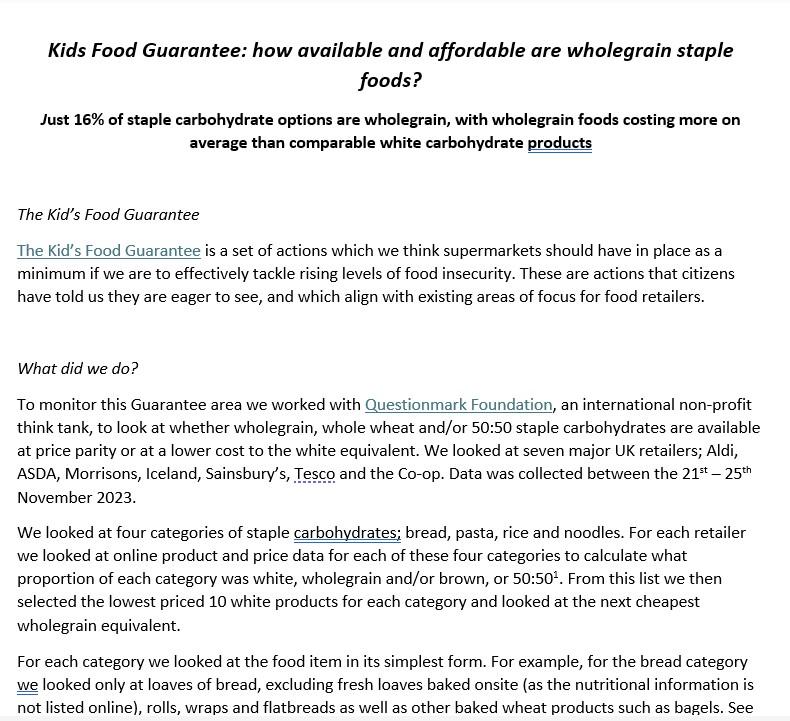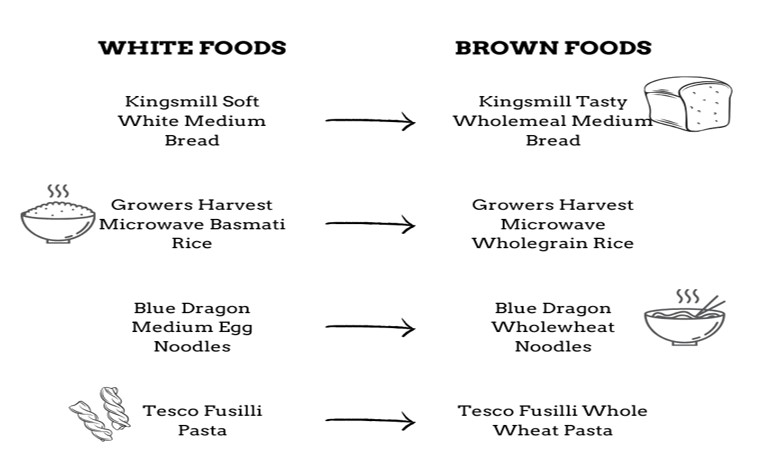
Kids Food Guarantee: How affordable are wholegrain staple foods?
Just 16% of staple carbohydrate options are wholegrain, with wholegrain foods costing more on average than comparable white carbohydrate products.
The Kid’s Food Guarantee
The Kid’s Food Guarantee is a set of actions which we think supermarkets should have in place as a minimum if we are to effectively tackle rising levels of food insecurity. These are actions that citizens have told us they are eager to see, and which align with existing areas of focus for food retailers.
What did we do?
To monitor this Guarantee area we worked with Questionmark Foundation, an international non-profit think tank, to look at whether white, wholegrain and/or whole wheat or brown, and 50:50 staple carbohydrates are available at price parity or at a lower cost to the white equivalent.
We looked at seven major UK retailers; Aldi, ASDA, Morrisons, Iceland, Sainsbury’s, Tesco and the Co-op. Data was collected between the 21st – 25th November 2023.
We looked at four categories of staple carbohydrates; bread, pasta, rice and noodles. For each retailer we looked at online product and price data for each of these four categories to calculate what proportion of each category was white, wholegrain and/or brown, or 50:50(1).
From this list we then selected the lowest priced 10 white products for each category and looked at the next cheapest wholegrain equivalent.
For each category we looked at the food item in its simplest form. For example, for the bread category we looked only at loaves of bread, excluding fresh loaves baked onsite (as the nutritional information is not listed online), rolls, wraps and flatbreads as well as other baked wheat products such as bagels.

See our technical report for more details on our methodology and our full list of inclusion and exclusion criteria.
There is no agreed definition of wholegrain in the UK nor a legal minimum requirement for a product to be called wholegrain. This means that even products with small amounts of unrefined grain ingredients can be called wholegrain.
To categorise products as wholegrain, we therefore looked first at the product name, and then at the first and second ingredient listed using a broad-brush definition of wholegrain to capture relevant products.
Cereals described as wholegrain, brown, whole meal and black were categorised as being unrefined or wholegrain carbohydrates.
Although this is not a foolproof methodology, and it is likely our figures are an overestimate of wholegrain products given the lack of regulation around wholegrain claims, it nevertheless still provides a useful indication of higher wholegrain (and therefore higher fibre) products within each category.
Why wholegrain?
The Government’s guidelines for a healthy diet (the Eatwell Guide) recommend that meals are based around starchy carbohydrate foods, such as bread, rice, or pasta, which should make up just over a third of the food we eat.
It specifically recommends that citizens choose higher fibre or wholegrain varieties of these foods, such as wholewheat pasta and brown rice. This is because the milling process used to produce white, refined versions of cereal foods removes the nutrient and fibre-rich brand and germ parts of the grain.
This means that wholegrains can contain up to 75% more nutrients than refined cereals and have a number of health benefits, including reducing the risk of heart disease, type two diabetes and some cancers. Similar outcomes are linked with increased fibre consumption.
However, surveys show that 95% of adults don’t eat enough wholegrains (a great source of fibre) and nearly one in three of us get none at all.
Intakes of fibre are also very low, with just 9% of adults meeting the recommended daily intake of fibre. The National Food Strategy for England recommended that intakes of fibre ought to increase by 30% by 2030 in order to meet both health and environmental goals. Making it easier for everyone to eat more wholegrain foods would be one way of encouraging this dietary shift.
The Kids Food Guarantee therefore asks all retailers to ensure that wholegrain and/or 50:50 cereal products are at price parity or at a lower price to the refined equivalent.
How available are wholegrain staple carbohydrates?
Across all four carbohydrate categories we looked at, the majority of available options are white, unrefined products. Just one in six (16%) of all products were wholegrain, brown or 50:50, with a large degree of variation in availability across the four different categories we looked at.
It is easiest to find wholegrain or 50:50 options in the bread category, with just over a quarter (26%) of bread loaves available wholegrain, brown or 50:50 options.
Wholegrain and brown options are much more limited for pasta and rice, with just over one in 10 products available categorised as wholegrain or brown in these two categories (11% and 12% respectively).
Of all four categories analysed, it is hardest to find wholegrain or brown options when purchasing noodles, with just 6% of all available noodle options identified as wholewheat or wholegrain options.
Across the UK’s seven major retailers there is a notable difference in how available wholegrain staple carbohydrate options are among the different retailers.
Iceland, Aldi and Co-op have the smallest proportion of wholegrain staple carbohydrate options available, with just 5.6% of available pasta, bread, rice and noodle products categorised as wholegrain or 50:50 at Iceland.
Sainsbury’s, ASDA and Tesco have the largest amount of wholegrain cereal products available, with almost one in four (24%) of staple carbohydrate options at Sainsbury’s wholegrain or 50:50 varieties.
The cost of switching to wholegrain equivalents from white products – how affordable are wholegrain options?
To understand how affordable wholegrain options are relative to more refined, white options, we first selected the 10 cheapest white products available in each category for each retailer.
We then looked for a wholegrain or brown equivalent product of a similar size from the same brand (where applicable) and calculated the price per 100g for both products.
For example, the price of Kingsmill’s medium sliced wholemeal bread (800g) as sold in Sainsbury’s was compared to the price of Sainsbury’s Kingsmill’s soft white medium sliced bread (800g).

In all four categories the price of wholegrain and brown products is, on average, higher than the closest comparable white product.
Bread loaves have the smallest price difference, with wholegrain, brown and 50:50 products costing an average of 9p more than the nearest white equivalent.
The largest price differences can be seen in the noodle category (where only 6% of available options are wholemeal) and in the rice category, where brown or wholegrain rice options cost an average of 77p more than white rice.
Price is a major driver of food choice, so ensuring that more nutrient dense wholegrain staple foods are priced at parity, or below the more refined equivalents will be key for incentivising citizens to switch to wholegrain options.
Across the major retailers equivalent or lower pricing of wholegrain options in comparison to white comparable products is patchy.
White options are generally more affordable than the closest wholegrain equivalent. The best options for citizens are in the bread category, with Sainsbury’s, ASDA and Iceland offering price parity between their sliced wholemeal and white bread loaf options.
There are fewer lower cost options outside the bread category, although Tesco’s Grower’s Harvest microwave wholegrain and Long Grain rices are priced at equivalence, while wholewheat fusilli pasta is the same price as standard fusilli pasta at Coop.
The table below shows the pricing of equivalent products across the retailers in scope.
Recommendations
Wholegrain, higher fibre staple carbohydrates are both less available and on average more expensive than white, refined carbohydrates.
Retailers and manufacturers ought to look at increasing the availability of wholegrain options across all staple carbohydrate categories, with a particular focus on the pasta, rice and noodle categories which are currently dominated by white, more refined options.
Ensuring that wholegrain options are priced the same or below comparable white options is key for incentivising and supporting citizens to make healthier swaps.
Our previous Kids Food Guarantee reports looking at multibuys and price promotion deals found that only a very small proportion of offers are on staple carbohydrates.
Ensuring that where offered, such deals are on wholegrain carbohydrates would support citizens to increase their intake of wholegrains and higher fibre foods.
The government should consider the cost of healthy and sustainable diets when setting benefit levels and the national living wage in order to ensure that low income households are able to afford more nutrient dense foods, such as wholegrains, given that these can be a less affordable option relative to less nutrient dense foods.
They should also look to agree a consistent definition of wholegrain, to make sure that intakes of wholegrain foods can be more accurately monitored and tracked, and to ensure that health and nutrition claims to citizens are accurate and science based.
More generally, there is a need to increase the appeal of wholegrain and high fibre foods. Public health messaging ought to highlight the benefits of higher wholegrain, higher fibre foods, and - following the UK’s departure from the EU - the UK ought to review the list of approved claims that can be used to describe the health benefits of fibre to consumers. Currently these claims are not always very appealing to citizens, particularly when it comes to fibre.
______________________________________
(1) 50:50 products are found mostly in the bread category, and contain a mix of white and wholemeal flours. Brown bread products also contain a mixture of refined and whole wheat flour




